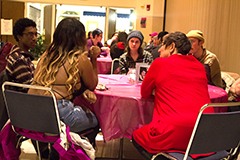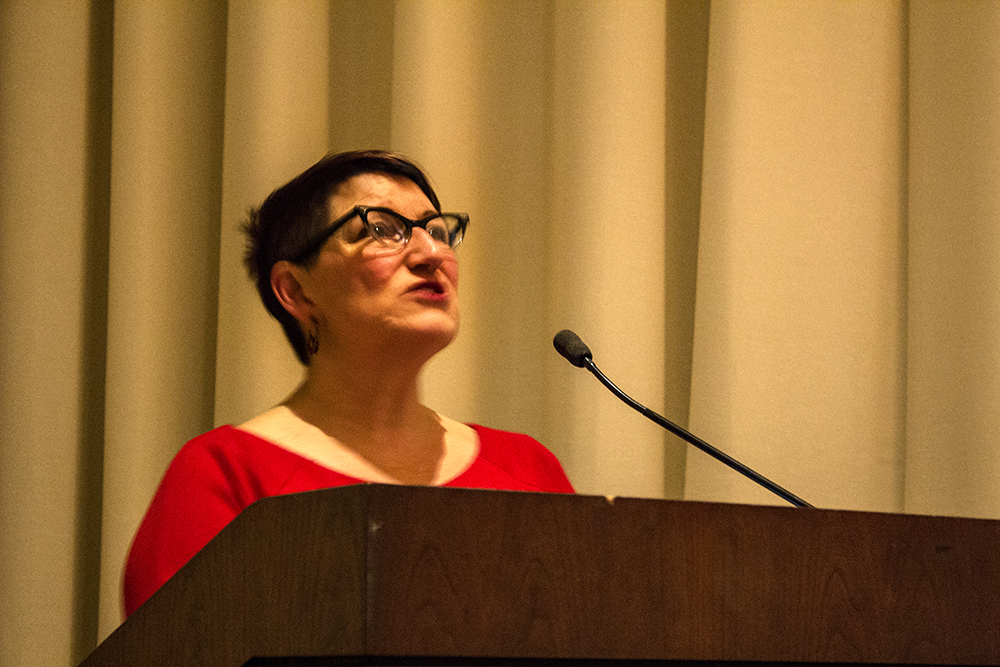Professor talks Women’s marches, history

Guests at the Women’s March discussion participate in table talk discussions that address their personal experiences regarding feminism and equality in the Martin Luther King Jr. Ball Room on wednesday evening.
January 24, 2018
Jeannie Ludlow, English professor and coordinator of the women’s, gender and sexuality studies program, spoke about the importance of Women’s Marches and the historical aspect of women’s rights Wednesday at the “Nevertheless, She Persisted” conference at the University Ballroom at the Martin Luther King Jr. University Union.
The conference started out with a PowerPoint presentation of the different Women’s Marches that have been held, beginning with the 2017 Women’s March and the Women’s March that was held a few weeks ago. Ludlow then spoke on the history of women’s rights and the issues that led to these marches and past marches.
“The first wave of feminism issues, which began around 1848, started with (suffrage), women wanting to have the right to vote,” Ludlow said. “This law did not pass until 1920.”
Ludlow explained that these issues were brought to attention by women working to end slavery in the abolition movement. These women wanted to end slavery and allow women to have citizenship, voting and property rights.
“If I was living during this time period, I would not have been allowed to vote, I would only have citizenship through a male family member and I would not have rights to any property,” Ludlow explained.

The women fighting for these rights started picketing outside the White House and eventually were arrested.
“The history of this sounds a lot like what we as women still go through today,” Ludlow added.
The first wave then led to African American women wanting to have the same rights as white women.
Ludlow said in 1913 several black women started taking part in marches, but they were told to walk in the back of the marches.
Between 1920 and 1950, Ludlow said that the feminism movement was considered to be inactive.
“This was not true,” Ludlow said. “Marches taking place during this time period were not as organized and vocal, but women were marching and working hard for social justice movements such as the labor movement.”
The second wave of feminism started around the 1960’s, and issues brought up during this period of time include women’s equality and abortion rights.
“During this time period, we saw a lot of people marching for various causes,” Ludlow said. “The first big march of this time was the Abortion Rights March in 1971.”
Ludlow said that we are currently in the midst of the third wave of feminism. The first big march of this time period was the Pro-Choice March in Washington, D.C. in 1992.
“This eventually led to women wondering who made the choice of abortion, themselves or the doctors,” Ludlow said. “Eventually the march was renamed to ‘March for Women’s Lives’ in 2004.”
Today, we see the millennial generation fighting for issues. Social Media has definitely influenced these issues with the #MeToo movement and the #BlackLivesMatter movement.
“The #MeToo movement is a hashtag movement that started with women coming out and being vocal about their experiences of being sexually assaulted,” Ludlow added.
The goals of these movements are to spread awareness of Trans and Non-Binary people, respect and inclusion.
After Ludlow’s speech, each table had a Q&A session. One of the major questions of the session was asking people what first made them want to bring change into the world.
Tess McArthy, ideas and issues coordinator of the UB, has been involved in labor marches most of her life.
“Attending these marches from the time I was very young is what truly inspired me to want to make change in this world,” McArthy said.
Jordan McLaren, vice chair of the UB, had her own reasons to want to bring change.
“I grew up with a single father who did his very best to inform me of feminist issues,” McLaren said. “He ended up having a girlfriend who became a strong role model to me and influenced me to want to change the world.”
The Women’s Movement is still a very active movement that continues to make change not just throughout America, but throughout the entire world.
Andrew Paisley can be reached at 581-2812 or at abpaisley@eiu.edu.

















![[Thumbnail Edition] Senior Foward Macy McGlone, getsw the ball and gets the point during the first half of the game aginst Western Illinois University,, Eastern Illinois University Lost to Western Illinois University Thursday March 6 20205, 78-75 EIU lost making it the end of their season](https://www.dailyeasternnews.com/wp-content/uploads/2025/03/WBB_OVC_03_O-1-e1743361637111-1200x614.jpg)


















































